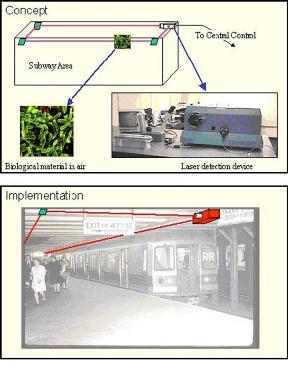Completed Investigation
The investigators integrated the laser technology into a demonstration system to test the principle of biological agent detection and characterization. The system was first set up and tested in a benign laboratory environment to demonstrate the ability to detect and differentiate the samples.
The investigators procured typical subway particulate matter from a New York subway station characteristic of what would be expected in an operational transit subway station environment. They tested the ability of the system to detect and distinguish biological contaminants in the presence of field particulate matter from subway stations.
Project Results
Laboratory setup for this investigation has been completed and the investigators have received certification from the government to work with dead target organisms. A literature review of available biological agent detection technologies has also been completed.
The biological material used in the tests has been detected and researchers have been able to separate the target agent from the particulate matter collected in the subway system. Detection sensitivity limits and identification time were evaluated. The tests will allow the investigators to assess this approach for transit applications.
Project Payoff Potential
If proven successful in a transit environment, this technology has potential to detect biological threat attacks in real time, to alert appropriate officials to the nature of a specific attack,
and to identify the biological agents. Beyond specific applications to subway systems, there is potential to translate the developments designed specifically for subway transit security into other possible transit applications.
Product Transfer
New York City Transit (NYCT) participated in the project by assisting the investigators in obtaining sample particulate matter from a typical subway station and by reviewing and commenting on the technical progress of the system. A final report describes the project activities, test design, and results.

Figure 1
Laser technology detection device concept and transit station application.
The final report for this IDEA project can be found at:
https://onlinepubs.trb.org/onlinepubs/archive/studies/idea/finalreports/transit/Transit35_Final_Report.pdf.